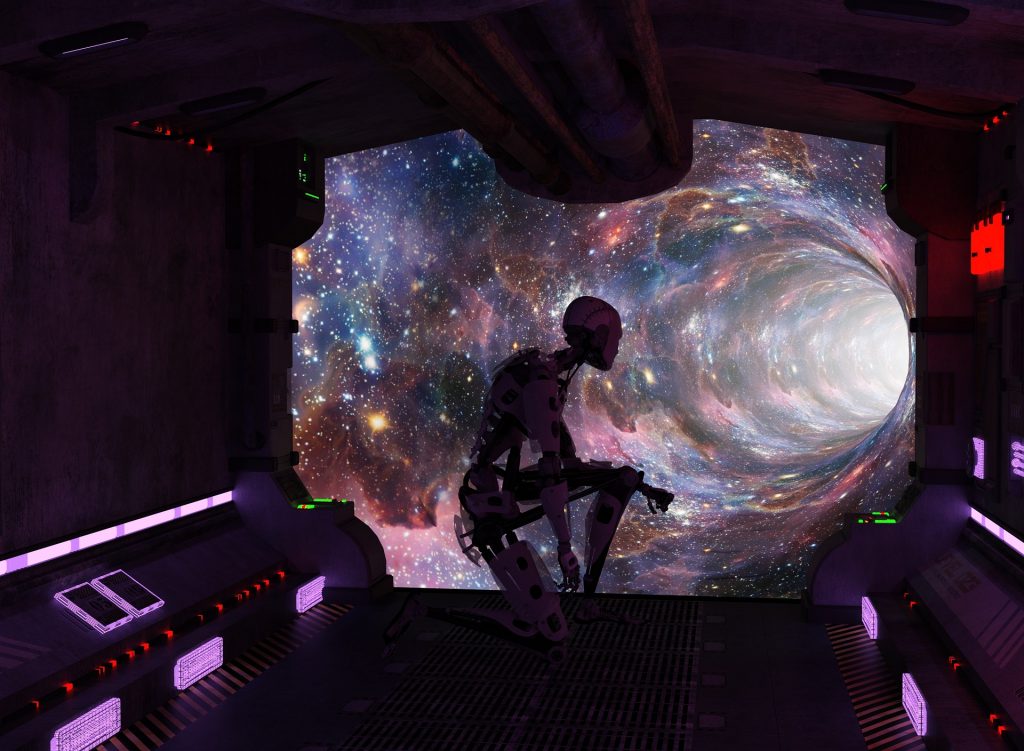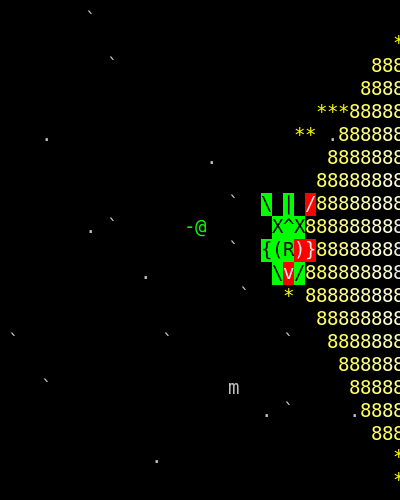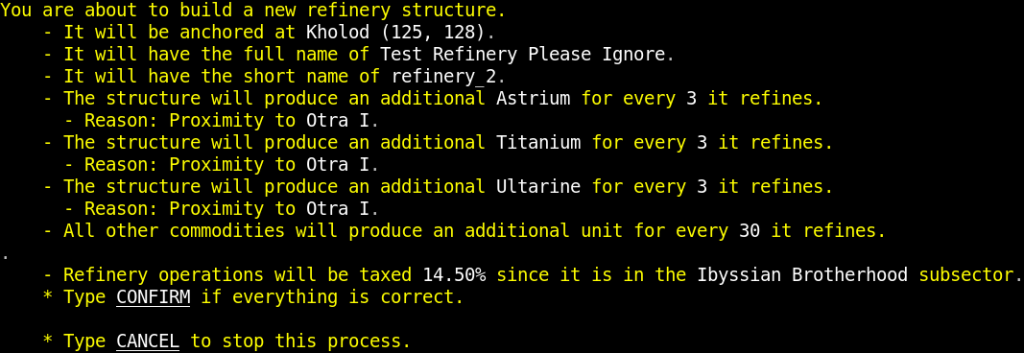The Industrial Revolution

Welcome back to Yet Another Devblog! Today, we are sharing a preview of the Economy Rework which, we are happy to announce, will be hitting the Starmourn Sector May 17th. So bust out your spreadsheets and slide rules, there’s a lot to cover!
Build-a-factory

One of my dreams for Starmourn has long been to give players the chance to construct monumental structures in space. That dream will soon be a reality: We have created a flexible “Space Structure” system which can handle any sort buildable space structure, and the first two such structures will be Refineries and Autofactories!
The structures themselves will require a significant number of commodities to build (around 15,000 refined inputs in total!). To help players start out in the revised economy, there will be NPC autofactory and refinery structures available across the Sector.
Structures are valid destinations for cargo contracts, can be docked with, have commodity storage, and you can even place market listings on them! Structures can be designated to Factions, Dynasties, and Clans, too!
Space Structures will require a small amount of maintenance in the form of Structural Repairkits stored locally. We don’t want this to be too onerous, but we also do need these structures to fall out of the sky eventually if their owner has completely abandoned them. This is something we will certainly have to fine-tune after launch to get just right. If a structure does fall out of the sky, your commodities and any docked ships will be rescued to your home station.
The Down-Low on Manufacturing 2.0

Manufacturing looks much the same as before: you refine your raws in a refinery, take the refined goods to an autofactory, and specify the number of batches you’d like to run. New refineries and autofactories will have no “Type” associated with them, meaning ALL refineries can refine ALL goods, and ALL autofactories can manufacture ALL recipes. Economies remain, however, so you’ll still be incentivized to build remote structures to take advantage of economy bonuses, however. More on production bonuses later.
Presently, the time jobs take to complete is the major bottleneck in the player economy. In the rework, we want the bottleneck to be mining. Recipes will instead now have a “Cycles” cost, which represents the complexity of the manufacturing task. Structures, meanwhile, will have a “Production Speed” stat (how often will ticks occur?) and a “Production Cycles” stat (how many Cycles do we manufacture each tick). The end result is that jobs will happen anywhere from 2.5x faster than before, to 500x faster than before for a fully upgraded and specialized structure.
On the subject of upgrades and specialization, the image above hints at another aspect here: Structure Modules. There are about 50 different structure modules you can build and upgrade across three tiers. There are modules to boost your Cycles, Speed, Cycles required for particular recipes, enhance your Production Bonus for a certain refined good or Autofactory category, and even modules that reduce the required inputs for recipes.
Bonuses

On the subject of Production Bonuses: Those are still a thing. Before you finalize the placement of your structure, you will be informed of what Production Bonuses you would receive based on proximity to celestial bodies and stations in economies with bonuses. As an added bonus, structures will always have a minimum production bonus and produce 1 extra every 30 output (about a 3% production bonus), so there will always be at least a bit of a production bonus no matter where you build. This is to help structure owners take advantage of a new incentive: owners can take a cut of bonus production.
After a non-trivial investment of time and resources, a refinery owner could bring down the required number of input Raw Titanium per refined Titanium from 5 all the way down to 3. Meanwhile, with a boosted Production Bonus, you could get as many as 1 extra per every 2 refined. 30 rawtitanium, instead of outputting 6 titanium, would now output 15. An autofactory owner could instead build up their “Titanium Efficiency” and “Duramine Efficiency” stats to bring the recipe for Transteel down from 4 titanium and 2 duramine to 2 titanium and 1 duramine! The hawk-eyed will notice a recipe change here… more on recipes later.
Jobs at a structure within a Subsector will be taxed a Production Tax. Factions will be able to set their Subsector’s Production Tax with all proceeds from tax going to the Faction. Structures in neutral space will, instead, be charged an Extortion rate starting at 10% piracy rating, 1% per 1% piracy, up to an egregious 100% Extortion at 100% Piracy Rating. No pirates, no tax.
As for charging your clients, structure owners will charge a fee per cycle, up to 2 decimal places. For instance, you could charge 1.25 marks per cycle, and a job submitted which will require 1000 cycles would thus charge the client 1250 marks before tax. We are still toying with the notion of the minimum price for jobs being 1.00 mark per cycle. We do want to have some kind of minimum price.
You may have noticed that Manufacturing Specializations must be pretty useless now, and they are. Which is why they are being deleted. The bonuses from mining yield will be tagged on to a buff of the crusher/compressor shipmods, instead.
There’s plenty else to cover, but I’ll just mention one more thing: Players with the “Manufacturing” org privilege will be able to submit jobs straight from org storage.
Going Official

Because buildable space structures aren’t enough: Introducing, Offices. Now, we reveal the master plan of just what space trucking was all about. We want manufacturers to have the option to spend the majority of their time establishing, monitoring, and constantly improving their Sector-wide supply chain, and spend less time setting up cargo contracts, queuing jobs, listing market offers, and generally doing things that are far too tedious for an ultra-busy titan of interstellar industry.
Offices glue all the economy systems together and allow you to set up a fully automated supply chain, from shipping raws to refineries, queuing jobs, shipping on to autofactories, queuing more jobs, shipping finished goods back to market hubs, and, finally, automatically posting to market at preset prices. Offices can be set up with Shipping, Manufacturing, or Marketing tasks which will trigger when the conditions that you set are satisfied. Once a task is set up, the task will always be performed until you delete it or disable it, ad infinitum. Set up some tasks, just add raws at your supply chain’s origin, and head to Lamentations and get shitfaced while your offices do all the hard work for you.
Oh, and orgs can set up Offices, too. Uses org comm storage, org cargo contracts, org jobs, org market offers, all the good stuff. Hope your commlogs are ready.
Cashflow for Spacers
… The devblog isn’t over yet?
Let’s start by ripping the bandaid off. After plenty of deliberation and math, the results are in: in the revised economy, you can expect to pay the Shipforge around 1000 marks for a kinetic battery or 7000 marks for an astromech.
Let’s break this down a bit. In a single Kinetic Battery, using a revised recipe (1 transteel, 1 disheet, 1 hdsastrium, 5 ultarine, see also below), after accounting for batch sizes of all involved intermediates, there are 2 refined comms in each battery (0.4 titanium, 0.2 magnaril, 0.2 diamene, 0.35 astrium, 0.35 iriil, and 0.5 ultarine to be precise. They did the studies), or 10 raws before bonuses. Meanwhile, the total cycle cost of 1 kinetic battery, again factoring in batch sizes and all intermediates, is 221 Cycles. That leaves us with 10 raws and 221 cycles.
We’ve already discussed the fact that 1 mark per Cycle as a structure fee will likely be our baseline. That means our kinetic battery costs at least 221 marks in theory (in practice, you can use your own structure in an untaxed environment to spend 0 marks on this). In the economy as we know it, miners get a pretty bad deal because there was never enough space built in for the cost of their labor. Let’s instead assume that we want to pay at least 50 marks per raw, a pricepoint I’m sure you’d all agree would make mining quite a lucrative activity, especially if there were effectively no cap on that price (the way PMOs are capped daily, Junk is softcapped, etc). We now get a result of 50 marks * 10 raws + 221 cycles * 1 mark per cycle = 721 marks. Add on an extra +50% for good measure (allowing manufacturers to price their goods in the space well below) and we end up with a price of 1082 marks for our single kinetic battery.
This is all to say, I’ve taken a lot of time and written a lot of code towards commodity valuation. It’s a tough balance, but ultimately having too-low NPC prices put a stranglehold on the whole system that makes it unprofitable for everyone involved.
One possibility is that there will be essentially infinite NPC buy orders for pretty much everything at a price point that factors in all of the above but leaves enough room for players to reasonably compete with them. The idea is that, if player manufacturers want to compete with NPC buy orders, they will have to pay miners and manufacturers of intermediates a living wage. We could also have NPC market offers selling ship consumables at all stations that sell shipforge supplies. These offers could be at egregious, but fluctuating prices and could supply plenty of volume. Now that Shipforge Supplies is already tied to the market, all commodities would effectively come from the market, but the Shipforge will always be there as an optional shorthand for using market syntax.
That said, we may not go in that direction just yet, but it’s something I’ll be keeping in mind while monitoring the overall health of the economy in the first couple months after release.
As usual with the release of big new eco systems, PMOs will likely be disabled for awhile after release, until the system has a chance to build up the 30-day comms consumption history that it needs to place sinks where they’re needed.
Recipe Rework

Recipe tweaks are still a work in progress, but here’s a bonus preview for you to close out the devblog. The approach to recipe tweaking was essentially to start by leaning on the lore of the Starmourn-specific materials, and the science of the real-life analogs. Next, I wanted to make sure we had a decent representation from every refined comm, and that recipes weren’t too heavily skewed in favor of one comm. Lastly, I wanted to factor in the new Efficiency stats from structures and make sure all the intermediate recipes in particular can benefit majorly from them. The majority of recipes have received at least some touchups, including all the ship ones, and there are a new slate of advanced intermediate commodities (see image) used specifically for structure and structure module building. For now, I will only share the intermediate recipes, and welcome feedback:
Paristeel: 5 titanium, 1 duramine > 4 titanium, 2 duramine Transteel: 5 titanium, 1 magnaril > 4 titanium, 2 magnaril Nanoplastic: 3 vandium, 4 ultarine, 9 helium11 > 2 vandium, 8 elessium, 11 helium11 Nanoplastic: Batch size 1 > 2 Disheet: 4 diamene > 10 diamene Disheet: Batch size 1 > 5 Hdsastrium: 2 astrium, 10 iriil > 7 astrium, 7 iriil Hdsastrium: Batch size 1 > 2 QPC: 2 astrium, 10 iriil > 1 hdsastrium, 3 stesium, 3 ultarine Array: 1 disheet, 1 rglass > 2 disheet, 5 magnaril, 5 elessium, 1 nanoplastic Rglass: Unchanged
That’s it for today! There’s still a lot of work to get done to make sure this massive content update is as bug-free and polished as it can be. But now you know what to expect when the Industrial Revolution lands on May 17th, which is coming up quick. There’s still plenty of opportunity to make tweaks to the system before launch, so we would love to hear your feedback! Feel free to comment below, on Discord, in game, or on the forums!
Regards,
Neritus
